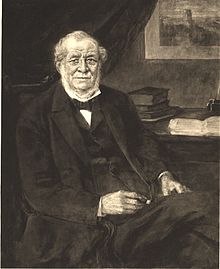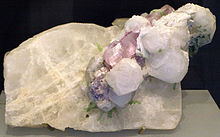Caesium
Caesium (by IUPAC) [ˈʦɛːzi̯ʊm] ![]() , standardly cesium, is a chemical element with the element symbol Cs and atomic number 55. In the periodic table, it is in the 1st main group, or 1st IUPAC group, and belongs to the alkali metals. Caesium is the heaviest stable alkali metal.
, standardly cesium, is a chemical element with the element symbol Cs and atomic number 55. In the periodic table, it is in the 1st main group, or 1st IUPAC group, and belongs to the alkali metals. Caesium is the heaviest stable alkali metal.
Caesium was discovered in 1861 by Robert Wilhelm Bunsen and Gustav Robert Kirchhoff in the mineral water of the Maxquelle in Dürkheim. Due to the two blue spectral lines with which the element was detected, they named it after the Latin caesius for sky blue. The pure element could be represented for the first time in 1881 by Carl Theodor Setterberg.
Caesium is an extremely reactive, very soft, gold-coloured metal. Since it reacts immediately and very violently with air, it is stored in molten glass ampoules under inert gas.
A biological significance of the non-toxic element is not known. Due to its similarity to potassium, however, it is absorbed in the gastrointestinal tract and, analogous to potassium, is stored predominantly in muscle tissue. For this reason, the radioactive isotope cesium-137 (137Cs), a product of nuclear fission, attracted particular public attention when it was released into the environment in large quantities as a result of the Chernobyl disaster on 26 April 1986.
History
Caesium was first described in 1861 by Gustav Robert Kirchhoff and Robert Wilhelm Bunsen. They examined mineral water from Dürkheim and, after separating calcium, strontium, magnesium and lithium, discovered two previously unknown lines in the blue spectral range. From their observations, they concluded that there must be another, previously unknown element in the mineral water examined, which they named caesium, after the Latin caesius for "sky blue", because of the blue spectral lines.
Bunsen also attempted to separate cesium from the other alkali metals in order to explore further properties of the element. To do this, he added a platinum chloride solution to the solution in order to precipitate potassium and the newly discovered heavier alkali metals rubidium and cesium as an insoluble hexachloridoplatinate. The potassium could be removed by boiling several times in a little water. To obtain the pure chlorides, the platinum was reduced to the element with hydrogen so that the now water-soluble cesium and rubidium chlorides could be leached out. The separation of cesium and rubidium was accomplished by taking advantage of the different solubility of the carbonates in absolute ethanol, in which cesium carbonate is soluble in contrast to the corresponding rubidium compound. Cesium chloride also served Bunsen and Kirchhoff for a first determination of the molar mass of the new element, for which they found the value of 123.35 g/mol.
The two researchers were unable to obtain elemental cesium because electrolysis of molten cesium chloride produced a blue compound instead of the metal, which they called subchloride, but which was probably a colloidal mixture of cesium and cesium chloride. Electrolysis of an aqueous solution with a mercury anode formed the easily decomposable cesium amalgam.
The preparation of elemental caesium was finally achieved in 1881 by Carl Theodor Setterberg, who avoided the problems with chloride by using caesium cyanide for the fused-salt electrolysis. Initially, the relatively high temperature required to melt the cesium cyanide was a problem, but he was able to reduce this by eutecticizing with barium cyanide.

Robert Bunsen
Occurrence
With a content of 3 ppm in the continental earth's crust, cesium is a rare element on earth. It is the rarest alkali metal after the unstable francium. Due to its high reactivity, it does not occur elementally, but always in the form of compounds. Mostly cesium is a rare accompanying element in potassium or other alkali metal salts like lepidolite, but some cesium minerals are also known. The most common cesium mineral is pollucite, (Cs,Na)2Al2Si4O12 - H2O, which occurs in larger deposits mainly at Bernic Lake near Lac du Bonnet in the Canadian province of Manitoba at the Tanco mine. Other larger deposits are located in Bikita, Zimbabwe and in Namibia. The Tanco Mine deposits near Lac du Bonnet are the only ones where cesium is mined. Rarer cesium minerals include cesstibtantite (Cs,Na)SbTa4O12 and pautovite CsFe2S3.
Due to the water solubility of most cesium compounds, the element is dissolved in seawater; one litre contains an average of 0.3 to 4 micrograms of cesium. More common but less soluble elements such as nickel, chromium or copper are also found in comparable quantities.

Pollucit
Questions and Answers
Q: What is caesium?
A: Caesium is a chemical element with the atomic number 55 and its symbol is Cs.
Q: What group does caesium belong to?
A: Caesium belongs to the alkali metal group.
Q: What is the melting point of caesium?
A: The melting point of caesium is low, at 28°C.
Q: Is caesium reactive?
A: Yes, it is extremely reactive.
Q: What makes caesium a dangerous chemical?
A: Its high reactivity makes it dangerous. It can set itself on fire and explodes on contact with water.
Q: Why is caesium stored in mineral oil?
A: Caesium is stored in mineral oil because of its violent reaction with water.
Q: Is caesium a common element?
A: No, caesium is a rare element and is rather expensive because of the limited availability on Earth.
Search within the encyclopedia